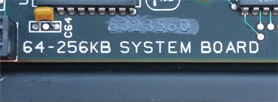| Parent |

| Bank 0: | 64 KB sized, | addressed 00000 to 0FFFF hex | ( 0 KB to 64 KB) (socketed) |
| Bank 1: | 64 KB sized, | addressed 10000 to 1FFFF hex | ( 64 KB to 128 KB) (socketed) |
| Bank 2: | 64 KB sized, | addressed 20000 to 2FFFF hex | (128 KB to 192 KB) (socketed) |
| Bank 3: | 64 KB sized, | addressed 30000 to 3FFFF hex | (192 KB to 256 KB) (socketed) |